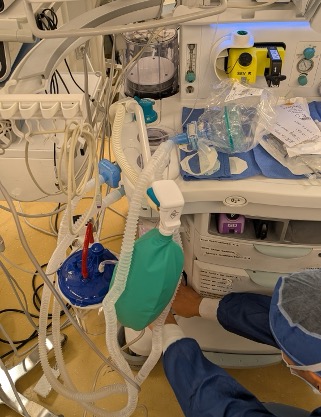UCSF Health is ushering in a new era of medical sustainability by adopting multi-use anesthesia breathing circuits, a device that delivers oxygen and anesthesia gases from the machine to the patients during surgery.
These reusable circuits, also known as ‘Multiple Patient Circuits,’ can be used for up to 24 hours when used in combination with a modern filter system, rather than being disposed of after each patient. While the practice of reusing breathing circuits has been proven to be safe and is standard in other countries across all income spectrums, the U.S. has yet to broadly adopt it.
This systemwide adoption will further strengthen UCSF Health’s commitment to reducing landfill waste, minimizing reliance on single-use devices, and promoting data-driven, evidence-based practices to build resilient health systems.
This change was rolled out beginning in December of 2024 at the Mission Bay Campus in the adult operating rooms under the supervision of Dr. Lee-Lynn Chen. The systemwide change is projected not only to eliminate tons of plastic landfill waste but also to contribute to annual cost savings per surgical case without compromising patient safety.
Medical Sustainability Director Seema Gandhi is recognized as a national leader in environmental sustainability and has spearheaded efforts to decrease emissions from anesthesia gases and supply waste in the operating rooms. For Gandhi, this effort is yet another example of UCSFH’s commitment to data, science, and advancing patient and population health by decreasing waste in US healthcare, which contributes 8.5% of national Greenhouse gas emissions.
“I asked around the top 20 US hospitals. No one is using circuits for 24 hours, while the data and evidence were unequivocal. I surveyed 45 countries across the globe and determined that UCSF Health is going to be the first health system to commit that across the health system for inpatients and outpatient surgery centers. That itself has a lot of merit in that we're often setting the path and leading the way. And it's always challenging to be the first,” Gandhi said, “The country looks up to us in the area of Environmental Stewardship, and efforts of eliminating harmful gases, decreasing waste from nitrous oxide have had a ripple effect nationally and globally, anesthesia circuits will be one such example too.”
 Multiple-use breathing circuit being connected to an anesthesia machine.
Multiple-use breathing circuit being connected to an anesthesia machine.
Leading the Way
This isn’t the first time UCSF Health has led the way for sustainability in healthcare. In 2023, UCSF Health was the first academic center in the country to deactivate the central piped nitrous oxide delivery system and transition to portable sources in anesthesia, a move that significantly reduced emissions and saved the university a reported $1.2 million. Gandhi then worked with the UC Office of the President to make this a UC-wide initiative at all five campuses.
Gandhi is hoping that this latest anesthesia initiative has a similar snowball effect for widespread adoption across the nation and encourages clinicians and staff to question wasteful practices.
Gandhi, UCSF Health’s inaugural Medical Sustainability Director, first in the UC system and among the first few appointed in the country, focuses her efforts on education, quality improvement, and research to minimize the improved value and decrease the harmful effects of global warming on human health and health systems.
“We tend to look at a problem only from our perspective and we've become very siloed in our workspace. I think that working in this area of sustainability has really opened my eyes beyond anesthesia. With the pressures of efficiency and competing priorities in providing quality care, sustainability-focused initiatives often seem like an added work burden, but they can be integrated into everything we do on a daily basis; in fact, they improve quality of care and efficiency. I'm glad that I've expanded my clinical career into this path of sustainability. I feel that I've met amazing people all across the health system, from nurses to supply chain to facility engineers, and it's really given me a broader perspective of healthcare. We are expanding our sustainability efforts into more areas, such as surgery, radiology, and pharmacy,” Gandhi said.
Gandhi's efforts include considering ways to not only make surgery greener but also reduce the need for surgery in the first place.
“My focus has been upstream. While waste segregation is important, the question we should be asking is how to create less waste in the first place. Look upstream and say: ‘Are we using all the supplies and medication as efficiently as we can?’ ‘Does this patient need this test and intervention?’ ‘Can we, as a health system, move towards more preventative care and minimize overtreatment?’”
For her part, Gandhi is now focusing on educational outreach through sharing the importance of healthcare sustainability actions with the next generation of UCSF learners.
“If we truly have to embrace sustainability and if we truly have to embrace prolonged change and impactful effort, then I think educating the next generation of providers is so important. With that, I started focusing on educating trainees and medical students around this topic via grand rounds and creating education modules.” Gandhi said.
Through research, advocacy, and education, the environmental efforts led by Gandhi and other sustainability champions at UCSF Health will continue to endure and expand, minimizing healthcare’s own contribution to the negative effects of climate change.